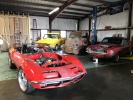
Originally Posted by
TimZ

Hi - sorry to resurrect an old thread, but it was the newest relevant one I could find. I'm just getting started tuning a low boost turbo setup on my son's S197, and this is my first time playing with returnless fuel. Here's the setup:
On3 67mm twin turbo
1000cc injectors (supplied with test data and properly transferred to the tune)
JMS PowerMax V2 BAP
Stock Pump (so far)
Stock fuel lines
E85
SCT Advantage SW (I'm new to SCT tuning in general and didn't know about HP Tuners until it was too late - the forum support is light years better here)
We are noticing similar pressure drops as have been noted elsewhere in this thread - I've got the fuel rail instrumented, and I'm dropping down to around 42psi at 7000 rpm and 6psi boost. I've matched up the inferred fuel pressure tables to match what I'm seeing (plus boost pressure), and I've gotten it to the point where it will maintain ~.75 lambda all the way out to 7000rpm and 6psi boost, but it's clearly on the edge at this point - I'm relatively certain that it doesn't have much left.
We've run the JMS at 18V and at 22V, and get pretty much the same results, pressure drop-wise. Unfortunately, I only have the pressure measurement at the rail, and not at the tank, but looking at the size of the fuel lines (as noted above) I'm thinking that a good deal of this pressure drop is through the lines, and that the pump may be holding 58psi when the BAP kicks in. Next order of operations is I'm going to increase the fuel line size to minimize that drop - I can report back the results if anybody is interested. If that doesn't help I'm thinking next step is the DW400 drop-in pump with an AN6 or AN8 bulkhead fitting as noted above.
So now I have some questions...
First, while setting up the inferred fuel pressure tables, they are in terms of Fuel Pump Flow Rate vs. Pressure across the injectors. I made some calculations as to what I thought I'd need out to ~10psi for future headroom and decided to make the flow rate column go out to 12lb/min. After datalogging this numerous times I'm finding that the Fuel Flow Rate from the ECU is capped at 8.0 lb/min - it just flatlines there. I can't find anyplace in the tune where I can change the upper limit for this, and I assume that if I went to a larger pump I'd still run into this, as the ECU has no idea that something different is going on here. This forces me to have to fudge the Inferred FP table to just show worst case at 8lb/min. Anybody else seen this? Is there a way to change the max flow rate that the ECU infers?
If I change to the DW400 (or any other drop-in upgrade pump for that matter), am I still limited to 58 psi? I can't seem to find info on where the Pressure Relief Valve resides - is it in the pump, or external to the pump, where it could be bypassed/modified?
If it's external and could be bypassed, I'm assuming that the 58psi PRV is an over-pressure safety device and not the regulator (i.e., if I bypassed it and changed nothing else the nominal pressure would still be ~55psi). Is this assumption correct?
If it's built into the pump, I'm assuming that a drop-in like the DW400 would have a different PRV setting (the Deatchwerks website says the DW400 has in internal relief pressure of 120psi) - if so, does the nominal pressure remain at ~55psi, or is it higher? It seems like it should be higher since it's running open loop with no real feedback mechanism - maybe the Pump Low Speed PWM settings could be adjusted?
It would be _nice_ if the nominal pressure stayed at or near 55psi while in the "low speed" mode, but was allowed to go higher when it switches to the high flow setting. Can anybody offer any insight on this?





 Reply With Quote
Reply With Quote



